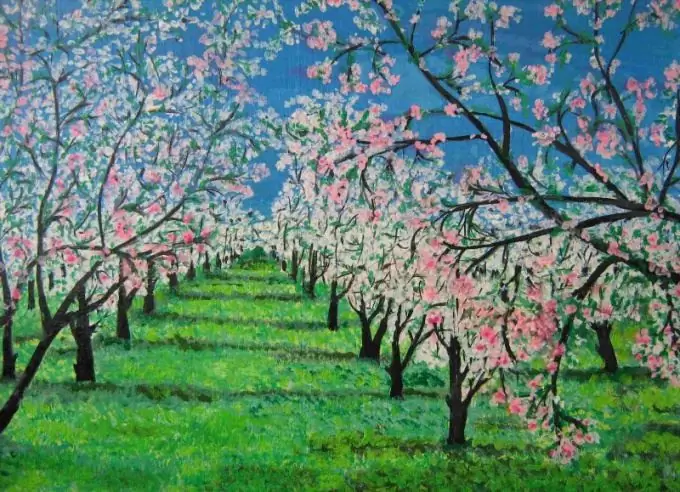The beauty of a blooming garden, which passes so quickly, begs for an artist's canvas. It is better to paint this landscape from nature, because only there you will feel the indescribable smell of apple blossom and touch the tenderness of a young cherry twig.

It is necessary
- - paper;
- - pencil;
- - gouache;
- - brushes;
- - palette;
- - a container for water;
- - sketchbook.
Instructions
Step 1
If you are just starting out as an artist and have no experience with oil, take gouache or acrylic paints with you. A regular sketchbook will do as well. Then you can, using your own sketches, paint a large picture on canvas.
Step 2
Find an area with the most beautiful views of a blooming garden and set yourself up for work. Sketch with a pencil, outline the horizon line, even rows of trees and a path between them. Then you can work with paints, because you do not achieve a photographic copy of a real place, and it is easier to depict trees using brushes.
Step 3
Start painting with the sky, grass and paths. The firmament will be almost hidden by the crowns of flowering trees, so one correct tone will be enough to fill the top of the picture with it. If the young shoots completely cover the ground, pick up a few of the desired shades of green and use vertical thin brush strokes to paint fresh shoots.
Step 4
Pay attention to the direction of the light, because all objects cast a shadow, and you need to note for yourself the position of the sun in the sky.
Step 5
Mix the paint to depict the trunks with dark bark near the ground and lighter at the top. Use a soft round brush to paint the bases of the fruit trees. Remember the direction of the light. Draw the dark trunks first, wait for the paint to dry. Then apply the lighter color on the sunny side. Work in stages, do not draw every element. First, you will have a garden of some trunks.
Step 6
Change the brush to a thinner one and paint large branches with it. Draw dark cracks on the bark. The next stage is the image with the thinnest brush and lighter paint of thin twigs that look like a translucent spider web. Choose a darker color for the shadow on the grass.
Step 7
When fruit trees are in bloom, their leaves are still very small and have a fresh green color. Try to get this shade in your palette by experimenting with mixing greens, yellows, and whites. Create two to three tones for a more natural looking garden. With a thin round brush, randomly apply strokes with the resulting paint on the branches. Change your tone and do the same.
Step 8
Now mix paint to paint the flowers. Take white, reds, blues and purples, look at the garden and carefully add the drops of different shades. You may need at least three tones, because the petals are not uniform in color. Dab with a medium round brush. Finish applying one shade, move on to another.
Step 9
Step away from the painting and look at it from afar to determine what more work needs to be done.






